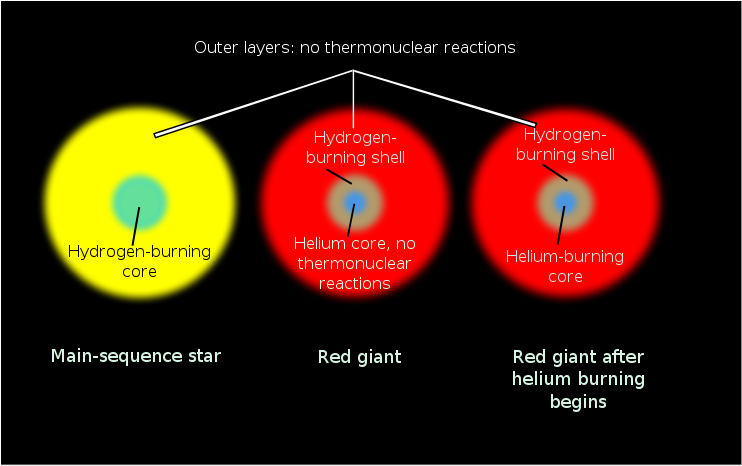Just in time for Halloween, my topic this week focuses on electron degeneracy pressure specifically to delve into how “A degenerate gas does not expand when the temperature increases as an ordinary gas does.”
In 1923, Arthur Stanley Eddington derived a formula to relate the luminosity of a star to its mass, and in the same year correctly interpreted high-density, white dwarf stars as being formed of matter so dense that atomic electrons have collapsed from their orbits, a substance we now call degenerate matter. (Levy, p. 116)
Young giant stars of a certain size, between .4 and 2 solar masses, have helium rich cores squeezed by gravitational force into a crystal-like solid. At these pressures, the atoms become completely ionized, separately into nuclei and electrons and are so closely crowded together that become influenced by the Pauli exclusion principle phenomenon. Two identical particles are not allowed to exist in the same place and time. As the electrons are pressed closer and closer together, the exclusion principle forces many of them to move faster and faster so they do not become ‘identical’ (meaning occupying the same space and moving with the same speed of adjacent electrons) and consequently this motion increases the repulsion between the electrons. This state provides pressure in the core preventing it from collapsing and is referred to by astronomers as degeneracy. Thus, low-mass giants with helium-rich cores are supported by electron degeneracy pressure. (Comins, p. 335)

If that wasn’t bizarre enough, here’s where it gets weirder: A degenerate core’s pressure does not change with temperature. Normally, when temperature increases, pressure increases, causing gases to expand and cool. Since the low-mass giant’s core cannot expand and cool when it overheats, it continues to get hotter and hotter, eventually reaching the threshold where core helium fusion begins, at roughly 100 million K. The fusion creates energy, increasing the core’s temperature further, but still the degenerate core’s pressure doesn’t increase. During the first few hours of helium fusion, both the rate of fusion and the temperature of the core increases dramatically, in what’s referred to as a helium flash. There’s no visible flash; in fact, a helium-fusing giant actually ends up smaller, dimmer and hotter than before. (Comins, p. 335)
Helium fusion increases the temperature, which increases the fusion rate, which further increases the temperature in a runaway reaction. This produces a flash of very intense helium fusion that lasts only a few minutes, but briefly emits energy at a rate comparable to the entire Milky Way galaxy. (Helium Flash, Wikipedia)
Eventually, the core temperature reaches a point where the degenerate helium is forced to transform back into an ordinary gas, at least in this type of low-mass helium-rich giant, at which point the usual safety value operates causing expansion and cooling of the core, which in turn moderates the fusion rate. As it cools, it contracts, shrinking the star until it reaches hydrostatic equilibrium. (Comins, p. 335)
In other types of stars, degeneracy pressure can result in supernovae, neutron stars and black holes. “Degenerate matter is matter whose properties are determined by quantum mechanics. Matter becomes degenerate under the enormous pressures of very dense stellar remnants. . . . if pressure is increased to a certain point (the Chandrasekhar limit) the electrons approach the speed of light. There is nothing in this universe that can reach or exceed the speed of light. At this point degeneracy pressure is no longer able to support the pressure of the matter and the matter suddenly collapses. In astronomy this happens with core collapse supernovae.” (Degeneracy)

As I fell down this degenerate quantum mechanical rabbit hole, I did find a book I plan to request via interlibrary loan. I just have to decide if I want to 1995 first edition of An Introduction to Modern Astrophysics by Carroll and Ostlie, or the updated and retitled second edition published in 2006 An Introduction to Modern Stellar Astrophysics. Just some light reading to look forward to during the approaching long cold winter nights.
References
Comins, N. F. (2015). Chapter 11 The Lives of Stars from Birth Through Middle Age. In Discovering the essential universe (6th ed., pp. 317-346). New York, NY: W.H. Freeman and Company.
Degeneracy. (15, 1). Retrieved from http://www.sun.org/encyclopedia/degeneracy
Helium flash. (2017, October 10). In Wikipedia, The Free Encyclopedia. Retrieved 13:05, October 31, 2017, from https://en.wikipedia.org/w/index.php?title=Helium_flash&oldid=804684811
Knowing the universe – small lexicon. (n.d.). Retrieved from http://nrumiano.free.fr/PagesU/Elexique.html#degenere
Levy, D. H., & Wallach-Levy, W. (2001). 1919: Eddington, Einstein, Mercury and an Eclipse. In Cosmic Discoveries: The wonders of astronomy (pp. 116-117). Amherst, NY: Prometheus Books.


One thought on “Flashy, Bizarre, Weird Degeneracy”
Comments are closed.